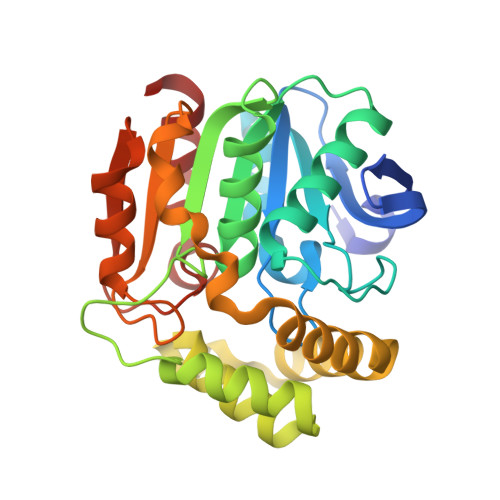Identification of an Acyl-Enzyme Intermediate in a meta-Cleavage Product Hydrolase Reveals the Versatility of the Catalytic Triad.
Ruzzini, A.C., Ghosh, S., Horsman, G.P., Foster, L.J., Bolin, J.T., Eltis, L.D.(2012) J Am Chem Soc 134: 4615-4624
- PubMed: 22339283
- DOI: https://doi.org/10.1021/ja208544g
- Primary Citation of Related Structures:
3V1K, 3V1L, 3V1M, 3V1N - PubMed Abstract:
Meta-cleavage product (MCP) hydrolases are members of the α/β-hydrolase superfamily that utilize a Ser-His-Asp triad to catalyze the hydrolysis of a C-C bond. BphD, the MCP hydrolase from the biphenyl degradation pathway, hydrolyzes 2-hydroxy-6-oxo-6-phenylhexa-2,4-dienoic acid (HOPDA) to 2-hydroxypenta-2,4-dienoic acid (HPD) and benzoate. A 1.6 Å resolution crystal structure of BphD H265Q incubated with HOPDA revealed that the enzyme's catalytic serine was benzoylated. The acyl-enzyme is stabilized by hydrogen bonding from the amide backbone of 'oxyanion hole' residues, consistent with formation of a tetrahedral oxyanion during nucleophilic attack by Ser112. Chemical quench and mass spectrometry studies substantiated the formation and decay of a Ser112-benzoyl species in wild-type BphD on a time scale consistent with turnover and incorporation of a single equivalent of (18)O into the benzoate produced during hydrolysis in H(2)(18)O. Rapid-scanning kinetic studies indicated that the catalytic histidine contributes to the rate of acylation by only an order of magnitude, but affects the rate of deacylation by over 5 orders of magnitude. The orange-colored catalytic intermediate, ES(red), previously detected in the wild-type enzyme and proposed herein to be a carbanion, was not observed during hydrolysis by H265Q. In the newly proposed mechanism, the carbanion abstracts a proton from Ser112, thereby completing tautomerization and generating a serinate for nucleophilic attack on the C6-carbonyl. Finally, quantification of an observed pre-steady-state kinetic burst suggests that BphD is a half-site reactive enzyme. While the updated catalytic mechanism shares features with the serine proteases, MCP hydrolase-specific chemistry highlights the versatility of the Ser-His-Asp triad.
Organizational Affiliation:
Department of Biochemistry and Molecular Biology, University of British Columbia, Vancouver BC V6T 1Z3, Canada.
















